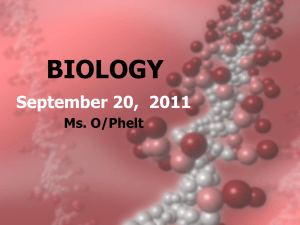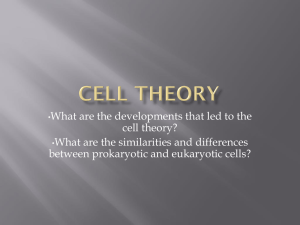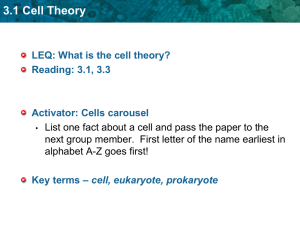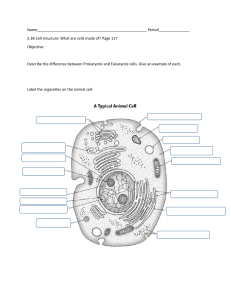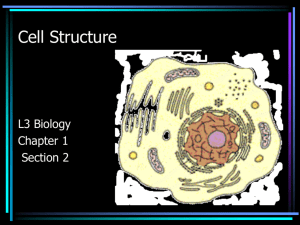Chapter 3
advertisement
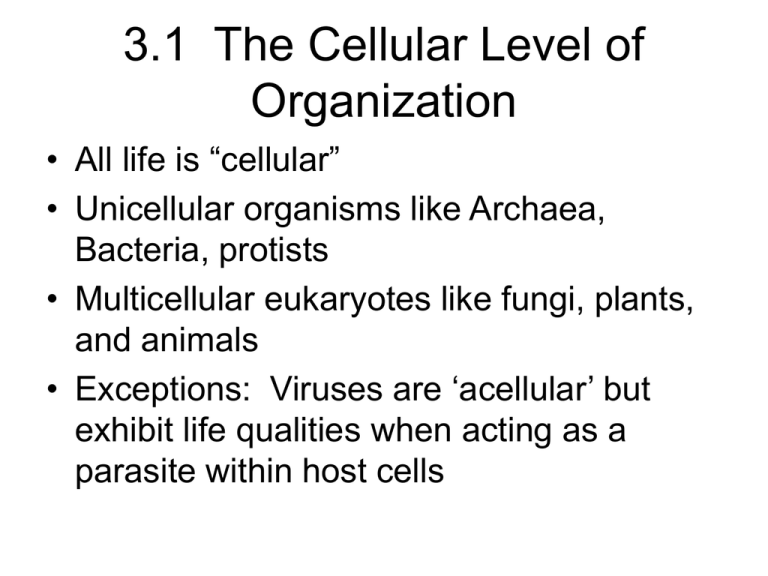
3.1 The Cellular Level of Organization • All life is “cellular” • Unicellular organisms like Archaea, Bacteria, protists • Multicellular eukaryotes like fungi, plants, and animals • Exceptions: Viruses are ‘acellular’ but exhibit life qualities when acting as a parasite within host cells 3.1 The Cellular Level of Organization • The cell is the structural and functional unit of an organism, the smallest structure capable of performing all the functions necessary for life. 3.1 The Cellular Level of Organization • Prokaryotic cells lack membrane enclosed structures. No nucleus or “organelle” compartments • Eukaryotic cells possess membrane enclosed structures. Prominent nucleus and distinct compartments - organelles The Cell Theory • All organisms are composed of one or more cells. • Robert Hooke, Louis Pasteur, Leuwenhoek, Virchow and others helped form the “cell theory” The Cell Theory • All organisms are composed of one or more cells. • Cells are the basic living unit of structure and function in organisms. The Cell Theory • All organisms are composed of one or more cells. • Cells are the basic living unit of structure and function in organisms. • All cells come only from other cells. Sizes of Living Things Surface Area / Volume Ratio • The amount of surface area affects the ability to get materials in and out of a cell. • Cells are “small”. Their size is limited. Size is limited by S/V ratio. Surface Area / Volume Ratio • The amount of surface area affects the ability to get materials in and out of a cell. • A cells increase in volume, the proportionate amount of surface area decreases. Surface Area / Volume Ratio Plasma Membrane and Cytoplasm • All cells are surrounded by a plasma membrane (AKA cytoplasmic memb., cell memb.). • The material inside of a cell is the cytoplasm. • The plasma membrane regulates what enters and exits a cell. 3.2 Prokaryotic Cells • Smaller in size than Eukaryotes (1 – 10 microns) • Unicellular, no nucleus or organelles • Archaea • Bacteria 3.2 Prokaryotic Cells 3.2 Prokaryotic Cells • Cell Wall - Unique Polysaccharide, Peptidoglycan • Capsule- Sugar coat • Flagellum - Motor • Nucleoid - DNA • Ribosomes 3.2 Prokaryotic Cells • Cell Wall • Capsule • Flagellum • Nucleoid • Ribosomes Prokaryotes are: • Structurally simple • Metabolically diverse • Adapted to most types of environments 3.2 Prokaryotic Cells 3.3 Eukaryotic Cells • Larger in size than Prokaryotes (10 to 50 microns) • Membrane bound organelles (compartments with specialized functions) 3.3 Eukaryotic Cells • Eukaryotic cells: – Are structurally complex – Have a nucleus – Possess membrane-bound organelles – May have a cell wall 3.3 Eukaryotic Cells 3.3 Eukaryotic Cells – Review these for assessment test, particularly the animal cell The Nucleus • Stores DNA The Nucleus • Stores DNA • Nucleolus - rRNA The Nucleus • Stores DNA • Nucleolus - rRNA • Nuclear Envelope – Nuclear pores Ribosomes • Site of protein synthesis • Two subunits (large and small) – Subunits consist of rRNA and protein molecules • Polyribosomes – Several ribosomes with a single mRNA molecule Endoplasmic Reticulum • Consists of membranous channels and saccules Endoplasmic Reticulum • Rough ER – Processing and modification of proteins • Smooth ER – Synthesizes phospholipids – Various other functions Golgi Apparatus • The Golgi apparatus collects, sorts, packages, and distributes materials such as proteins and lipids. Lysosomes • Lysosomes contain digestive enzymes that break down unwanted, foreign substances or wornout parts of cells Vacuoles • Vacuoles are membranous sacs that store substances. – For example: Water Pigments Toxins Peroxisomes • Membrane bound vesicles containing enzymes. – The enzymes break down molecules and as a result produce hydrogen peroxide. – Toxic oxygen waste products – free radicals, can cause serious problems – Detoxification by special enzymes like SOD to less toxic hydrogen peroxide – Hydrogen peroxide is broken down to water and oxygen by the enzyme catalase Energy-Related Organelles • Chloroplasts • Mitochondria Energy-Related Organelles Photosynthesis Cellular Respiration Chloroplasts • Site of photosynthesis • Structure: – Double-membrane – Stroma – Grana • Thylakoids • Chloroplasts contain: – Their own DNA – Ribosomes – Enzymes Mitochondria • Found in all eukaryotic cells • Site or cellular respiration • Structure: – Double-membrane – Matrix – Crista The Cytoskeleton • Maintains cell shape • Assists in movement of cell and organelles • Assemble and disassemble as needed • Three types of macromolecular fibers – Actin Filaments – Intermediate Filaments – Microtubules Actin Filaments • • • • Anchored to the plasma membrane Allows intestinal microvilli to expand and contract Found in pseudopods allowing amoeboid movement Play a role in animal cell division Actin Filaments • Actin interacts with motor molecules such as myosin. • In the presence of ATP, myosin pulls actin along • Example: muscle cells Intermediate Filaments • Intermediate in size between actin filaments and microtubules • Functions: – Support nuclear envelope – Cell-cell junctions, such as those holding skin cells tightly together Microtubules • Hollow cylinders made of two globular proteins • Assembly: – Under control of Microtubule Organizing Center (MTOC) – Most important MTOC is centrosome • Interacts with specific proteins to cause movement of organelles Microtubule Operation Centrioles • Short cylinders with a 9 + 0 pattern of microtubule triplets Centrioles • Help organize microtubules during animal cell division • May be involved with microtubule formation and in the organization of cilia and flagella Cilia and Flagella • Hairlike projections that aid in cell movement • In eukaryotic cells, cilia are much shorter than flagella • They are membrane-bound cylinders enclosing a matrix area – The matrix consists of microtubules in a 9 + 2 pattern Cilia and Flagella

